Multi-Hazard Livelihood Security and Resilience of Lower Mekong Basin Communities
Abstract
:1. Introduction
2. Literature Review
2.1. Multi-Hazard Vulnerability and Risk in the LMB
2.2. Concept of Livelihood and Resilience
2.3. Livelihood and Resilience Assessment
3. Material and Methods
3.1. Study Area
3.2. Data and Methods
4. Results
4.1. Spatial Distribution of Annual Precipitation
4.2. Temporal Distribution of Drought Events
4.3. Analysis of Drought Characteristics
4.4. Analysis of Flood Characteristics
4.5. Resilience Capacities of LMB Communities
5. Discussion
5.1. Multi-Hazard Livelihood Resilience Perspective in the LMB
5.2. Need for Livelihood Resilience Framework in the LMB
5.3. Livelihood Security and Resilience Assessment Framework (LiSeRA) for LMB
6. Conclusions
Author Contributions
Funding
Institutional Review Board Statement
Informed Consent Statement
Data Availability Statement
Acknowledgments
Conflicts of Interest
References
- Mekong River Commission. State of the Basin Report 2010; Mekong River Commission: Laos, Vientiane, 2010. [Google Scholar]
- Osborne, M. Why We Should be Worried about the Mekong River’s Future: A Perspective on Forty Years of Great Change. Perspective 2019, 105, 1–6. [Google Scholar]
- Jacobs, J.W. Mekong Committee History and Lessons for River Basin Development. Geogr. J. 1995, 161, 135. [Google Scholar] [CrossRef]
- Morton, L.W.; Olson, K.R. The Pulses of the Mekong River Basin: Rivers and the Livelihoods of Farmers and Fishers. J. Environ. Prot. 2018, 9, 431–459. [Google Scholar] [CrossRef]
- Pal, I.; Doydee, P.; Utarasakul, T.; Jaikaew, P.; Bin Razak, K.A.; Fernandez, G.; Huang, T.; Chen, C.S. System approach for flood vulnerability and community resilience assessment at the local level—A case study of Sakon Nakhon Province, Thailand. Kasetsart J. Soc. Sci. 2021, 42, 107–116. [Google Scholar] [CrossRef]
- Bui, N.; Pal, I.; Pramanik, M.; Dasgupta, R. The Impact of Climate Change on Drought and Its Adaptation Strategies: Findings from Regional Climate Models and Households in Tien Giang Province, Vietnam. Clim. Change 2022, 175, 18. [Google Scholar] [CrossRef]
- Few, R.; Tran, P.G. Climatic hazards, health risk and response in Vietnam: Case studies on social dimensions of vulnerability. Glob. Environ. Chang. 2010, 20, 529–538. [Google Scholar] [CrossRef]
- Abhishek, A.; Das, N.N.; Ines, A.V.; Andreadis, K.M.; Jayasinghe, S.; Granger, S.; Ellenburg, W.L.; Dutta, R.; Quyen, N.H.; Markert, A.M.; et al. Evaluating the impacts of drought on rice productivity over Cambodia in the Lower Mekong Basin. J. Hydrol. 2021, 599, 126291. [Google Scholar] [CrossRef]
- Chen, A.; Emanuel, K.A.; Chen, D.; Lin, C.; Zhang, F. Rising future tropical cyclone-induced extreme winds in the Mekong River Basin. Sci. Bull. 2020, 65, 419–424. [Google Scholar] [CrossRef]
- Thilakarathne, M.; Sridhar, V. Characterization of future drought conditions in the Lower Mekong River Basin. Weather. Clim. Extrem. 2017, 17, 47–58. [Google Scholar] [CrossRef]
- Trung, L.D.; Duc, N.A.; Nguyen, L.T.; Thai, T.H.; Khan, A.; Rautenstrauch, K.; Schmidt, C. Assessing cumulative impacts of the proposed Lower Mekong Basin hydropower cascade on the Mekong River floodplains and Delta—Overview of integrated modeling methods and results. J. Hydrol. 2018, 581, 122511. [Google Scholar] [CrossRef]
- Liu, L.; Bai, P.; Liu, C.; Tian, W.; Liang, K. Changes in Extreme Precipitation in the Mekong Basin. Adv. Meteorol. 2020, 2020, 8874869. [Google Scholar] [CrossRef]
- Nguyen, T.P.L.; Sean, C. Do climate uncertainties trigger farmers’ out-migration in the Lower Mekong Region? Curr. Res. Environ. Sustain. 2021, 3, 100087. [Google Scholar] [CrossRef]
- Zhang, L.; Song, W.; Song, W. Assessment of Agricultural Drought Risk in the Lancang-Mekong Region, South East Asia. Int. J. Environ. Res. Public Health 2020, 17, 6153. [Google Scholar] [CrossRef]
- Spruce, J.; Bolten, J.; Mohammed, I.N.; Srinivasan, R.; Lakshmi, V. Mapping Land Use Land Cover Change in the Lower Mekong Basin From 1997 to 2010. Front. Environ. Sci. 2020, 8, 21. [Google Scholar] [CrossRef] [PubMed]
- Tanner, T.; Lewis, D.; Wrathall, D.; Bronen, R.; Cradock-Henry, N.; Huq, S.; Lawless, C.; Nawrotzki, R.; Prasad, V.; Rahman, M.A.; et al. Livelihood resilience in the face of climate change. Nat. Clim. Chang. 2014, 5, 23–26. [Google Scholar] [CrossRef]
- Orencio, P.M.; Fujii, M. A localized disaster-resilience index to assess coastal communities based on an analytic hierarchy process (AHP). Int. J. Disaster Risk Reduct. 2013, 3, 62–75. [Google Scholar] [CrossRef]
- Hoang, L.P.; Biesbroek, R.; Tri, V.P.D.; Kummu, M.; van Vliet, M.T.H.; Leemans, R.; Kabat, P.; Ludwig, F. Managing flood risks in the Mekong Delta: How to address emerging challenges under climate change and socioeconomic developments. AMBIO 2018, 47, 635–649. [Google Scholar] [CrossRef] [PubMed]
- Arias, M.E.; Holtgrieve, G.W.; Ngor, P.B.; Dang, T.D.; Piman, T. Maintaining perspective of ongoing environmental change in the Mekong floodplains. Curr. Opin. Environ. Sustain. 2019, 37, 1–7. [Google Scholar] [CrossRef]
- Mekong River Commission. Annual Report of MRC 2019; Mekong River Commission Secretariat: Laos, Vientiane, 2020. [Google Scholar]
- Gunawardana, S.K.; Shrestha, S.; Mohanasundaram, S.; Salin, K.R.; Piman, T. Multiple drivers of hydrological alteration in the transboundary Srepok River Basin of the Lower Mekong Region. J. Environ. Manag. 2020, 278, 111524. [Google Scholar] [CrossRef]
- Dang, A.T.N.; Kumar, L.; Reid, M.; Nguyen, H. Remote Sensing Approach for Monitoring Coastal Wetland in the Mekong Delta, Vietnam: Change Trends and Their Driving Forces. Remote. Sens. 2021, 13, 3359. [Google Scholar] [CrossRef]
- Dore, J.; Lebel, L. Deliberation and Scale in Mekong Region Water Governance. Environ. Manag. 2010, 46, 60–80. [Google Scholar] [CrossRef] [PubMed]
- Islam, S.T.; Akand, K.; Islam, N.; Samad, S.; Rishal, F.H. Systems thinking approach for disaster resilient and climate smart agriculture in Bangladesh. Int. J. Disaster Resil. Built Environ. 2022, 13, 286–303. [Google Scholar] [CrossRef]
- Mavhura, E. Applying a systems-thinking approach to community resilience analysis using rural livelihoods: The case of Muzarabani district, Zimbabwe. Int. J. Disaster Risk Reduct. 2017, 25, 248–258. [Google Scholar] [CrossRef]
- Hansson, S.; Orru, K.; Siibak, A.; Bäck, A.; Krüger, M.; Gabel, F.; Morsut, C. Communication-related vulnerability to disasters: A heuristic framework. Int. J. Disaster Risk Reduct. 2020, 51, 101931. [Google Scholar] [CrossRef]
- Lecegui, A.; Olaizola, A.M.; López-I-Gelats, F.; Varela, E. Implementing the livelihood resilience framework: An indicator-based model for assessing mountain pastoral farming systems. Agric. Syst. 2022, 199, 103405. [Google Scholar] [CrossRef]
- Sina, D.; Chang-Richards, A.Y.; Wilkinson, S.; Potangaroa, R. A conceptual framework for measuring livelihood resilience: Relocation experience from Aceh, Indonesia. World Dev. 2019, 117, 253–265. [Google Scholar] [CrossRef]
- Tariq, H.; Pathirage, C.; Fernando, T. Measuring community disaster resilience at local levels: An adaptable resilience framework. Int. J. Disaster Risk Reduct. 2021, 62, 102358. [Google Scholar] [CrossRef]
- Jones, L.; Constas, M.A.; Matthews, N.; Verkaart, S. Advancing resilience measurement. Nat. Sustain. 2021, 4, 288–289. [Google Scholar] [CrossRef]
- Uddin, M.S.; Haque, C.E.; Khan, M.N.; Doberstein, B.; Cox, R.S. “Disasters threaten livelihoods, and people cope, adapt and make transformational changes”: Community resilience and livelihoods reconstruction in coastal communities of Bangladesh. Int. J. Disaster Risk Reduct. 2021, 63, 102444. [Google Scholar] [CrossRef]
- Kim, V.; Tantanee, S.; Suparta, W. Gis-based flood hazard mapping using hec-ras model: A case study of lower mekong river, cambodia. Geogr. Tech. 2020, 15, 16–26. [Google Scholar] [CrossRef]
- Adger, W.N. Social and ecological resilience: Are they related? Prog. Hum. Geogr. 2000, 24, 347–364. [Google Scholar] [CrossRef]
- Folke, C. Resilience: The emergence of a perspective for social–ecological systems analyses. Glob. Environ. Chang. 2006, 16, 253–267. [Google Scholar] [CrossRef]
- Hills, T.; Pramova, E.; Neufeldt, H.; Ericksen, P.; Thornton, P.; Noble, A.; Weight, E.; Campbell, B.; McCartney, M. A Monitoring Instrument for Resilience; CCAFS Working Paper No. 96; CGIAR Research Program on Climate Change, Agriculture and Food Security (CCAFS): Copenhagen, Denmark, 2015; Available online: http://hdl.handle.net/10568/56757 (accessed on 4 January 2023).
- Keck, M.; Sakdapolrak, P. What is social resilience? Lessons learned and ways forward. Erdkunde 2013, 67, 5–19. [Google Scholar] [CrossRef]
- UNDP. Community Based Resilience Assessment (CoBRA) Conceptual Framework and Methodology; UNDP Drylands Development Centre: Nairobi, Kenya, 2013. [Google Scholar]
- Mayunga, J.S. Understanding and Applying the Concept of Community Disaster Resilience: A Capital-Based Approach; Summer Academy for Social Vulnerability and Resilience Building: Bonn, Germany, 2007; p. 1. [Google Scholar]
- Pimm, S.L. The complexity and stability of ecosystems. Nature 1984, 307, 321–326. [Google Scholar] [CrossRef]
- Patel, S.; Rogers, M.B.; Amlôt, R.; Rubin, G.J. What Do We Mean by ‘Community Resilience’? A Systematic Literature Review of How It Is Defined in the Literature. PLoS Curr. 2017, 9. [Google Scholar]
- Speranza, C.I.; Wiesmann, U.; Rist, S. An indicator framework for assessing livelihood resilience in the context of social–ecological dynamics. Glob. Environ. Chang. 2014, 28, 109–119. [Google Scholar] [CrossRef]
- Folke, C.; Carpenter, S.R.; Walker, B.; Scheffer, M.; Chapin, T.; Rockström, J. Resilience Thinking: Integrating Resilience, Adaptability and Transformability. Ecol. Soc. 2010, 15, 9. [Google Scholar] [CrossRef]
- Walker, B.H.; Abel, N.; Anderies, J.M.; Ryan, P. Resilience, Adaptability, and Transformability in the Goulburn-Broken Catchment, Australia. Ecol. Soc. 2009, 14, 24. [Google Scholar] [CrossRef]
- Lee, A.V.; Vargo, J.; Seville, E. Developing a Tool to Measure and Compare Organizations’ Resilience. Nat. Hazards Rev. 2013, 14, 29–41. [Google Scholar] [CrossRef]
- Sweetapple, C.; Fu, G.; Farmani, R.; Butler, D. General resilience: Conceptual formulation and quantitative assessment for intervention development in the urban wastewater system. Water Res. 2022, 211, 118108. [Google Scholar] [CrossRef]
- Trang, N.T.T.; Loc, H.H. Livelihood sustainability of rural households in adapting to environmental changes: An empirical analysis of ecological shrimp aquaculture model in the Vietnamese Mekong Delta. Environ. Dev. 2021, 39, 100653. [Google Scholar] [CrossRef]
- Zhou, W.; Guo, S.; Deng, X.; Xu, D. Livelihood resilience and strategies of rural residents of earthquake-threatened areas in Sichuan Province, China. Nat. Hazards 2021, 106, 255–275. [Google Scholar] [CrossRef] [PubMed]
- Mekuyie, M.; Jordaan, A.; Melka, Y. Understanding resilience of pastoralists to climate change and variability in the Southern Afar Region, Ethiopia. Clim. Risk Manag. 2018, 20, 64–77. [Google Scholar] [CrossRef]
- Fan, Y.; Shi, X.; Li, X.; Feng, X. Livelihood resilience of vulnerable groups in the face of climate change: A systematic review and meta-analysis. Environ. Dev. 2022, 44, 100777. [Google Scholar] [CrossRef]
- Nguyen, M.T.; Renaud, F.G.; Sebesvari, Z. Drivers of change and adaptation pathways of agricultural systems facing increased salinity intrusion in coastal areas of the Mekong and Red River deltas in Vietnam. Environ. Sci. Policy 2019, 92, 331–348. [Google Scholar] [CrossRef]
- Eshrati, L.; Mahmoudzadeh, A.; Taghvaei, M. Multi hazards risk assessment, a new methodology. Int. J. Health Syst. Disaster Manag. 2015, 3, 79–88. [Google Scholar]
- Quandt, A. Measuring livelihood resilience: The Household Livelihood Resilience Approach (HLRA). World Dev. 2018, 107, 253–263. [Google Scholar] [CrossRef]
- Lwin, K.K.; Pal, I.; Shrestha, S.; Warnitchai, P. Assessing social resilience of flood-vulnerable communities in Ayeyarwady Delta, Myanmar. Int. J. Disaster Risk Reduct. 2020, 51, 101745. [Google Scholar] [CrossRef]
- Abenir, M.A.D.; Manzanero, L.I.O.; Bollettino, V. Community-based leadership in disaster resilience: The case of small island community in Hagonoy, Bulacan, Philippines. Int. J. Disaster Risk Reduct. 2022, 71, 102797. [Google Scholar] [CrossRef]
- Koliou, M.; van de Lindt, J.W.; McAllister, T.P.; Ellingwood, B.R.; Dillard, M.; Cutler, H. State of the research in community resilience: Progress and challenges. Sustain. Resilient Infrastruct. 2018, 5, 131–151. [Google Scholar] [CrossRef]
- Thulstrup, A.W. Livelihood resilience and adaptive capacity: Tracing changes in household access to capital in central Vietnam. World Dev. 2015, 74, 352–362. [Google Scholar] [CrossRef]
- Mallick, B.; Sultana, Z.; Bennett, C.M. How do sustainable livelihoods influence environmental (non-)migration aspirations? Appl. Geogr. 2020, 124, 102328. [Google Scholar] [CrossRef]
- Triet, N.V.K.; Dung, N.V.; Hoang, L.P.; Le Duy, N.; Tran, D.D.; Anh, T.T.; Kummu, M.; Merz, B.; Apel, H. Future projections of flood dynamics in the Vietnamese Mekong Delta. Sci. Total. Environ. 2020, 742, 140596. [Google Scholar] [CrossRef] [PubMed]
- Bayissa, Y.; Maskey, S.; Tadesse, T.; Van Andel, S.J.; Moges, S.A.; Van Griensven, A.; Solomatine, D. Comparison of the Performance of Six Drought Indices in Characterizing Historical Drought for the Upper Blue Nile Basin, Ethiopia. Geosciences 2018, 8, 81. [Google Scholar] [CrossRef]
- Hayes, M.J.; Svoboda, M.; Wall, N.A.; Widhalm, M. The Lincoln Declaration on Drought Indices: Universal Meteorological Drought Index Recommended. Bull. Am. Meteorol. Soc. 2011, 92, 485–488. [Google Scholar] [CrossRef]
- Edwards, D.C.; McKee, T.B. Characteristics of 20th Century Drought in the United States at Multiple Time Scales. Department of Atmospheric Science, Colorado State University. 1997. Available online: http://weather.uwyo.edu/upperair/sounding.html (accessed on 3 May 2023).
- Climate Hazarad Center UC Santa Barbara. CHIRPS: Rainfall Estimates from Rain Gauge and Satellite Observations; Climate Hazards Group InfraRed Precipitation with Station Data (CHIRPS). 2023. Available online: https://www.chc.ucsb.edu/data/chirps (accessed on 3 May 2023).
- Joint Research Centre Data Catalogue. “Datasets: Floods”. Datasets. European Commission. 2023. Available online: https://data.jrc.ec.europa.eu/dataset?collection=FLOODS&q=Floods (accessed on 3 May 2023).
- Dottori, F.; Alfieri, L.; Bianchi, A.; Skoien, J.; Salamon, P. River Flood Hazard Maps for Europe and the Mediterranean Basin Region. 2021. Available online: https://dataoi.jorcg/10.ec.europa.eu/dataset2905/1d128b6c-a4ee-4858-9e34-6210707f3c81#citation (accessed on 3 May 2023).
- DFID. Sustainable Livelihoods Guidance Sheets; Department for International Development: London, UK, 1999; Available online: http://www.livelihoodscentre.org/documents/20720/100145/Sustainable+livelihoods+guidance+sheets/8f35b59f-8207-43fc-8b99-df75d3000e86 (accessed on 3 May 2023).
- IPCC. Climate Change 2022: Impacts, Adaptation and Vulnerability Summary of Policy Makers. In Climate Change 2022: Impacts, Adaptation and Vulnerability. Contribution of Working Group II to the Sixth Assessment Report of the Intergovernmental Panel on Climate Change; Cambridge University Press: Cambridge, UK; New York, NY, USA, 2022; pp. 3–33. [Google Scholar]
- Meuwissen, M.P.M.; Feindt, P.H.; Spiegel, A.; Termeer, C.J.A.M.; Mathijs, E.; De Mey, Y.; Finger, R.; Balmann, A.; Wauters, E.; Urquhart, J.; et al. A Framework to Assess the Resilience of Farming Systems. Agric. Syst. 2019, 176, 102656. [Google Scholar] [CrossRef]
- Carpenter, S.; Walker, B.; Anderies, J.M.; Abel, N. From Metaphor to Measurement: Resilience of What to What? Ecosystems 2001, 4, 765–781. [Google Scholar] [CrossRef]
- Nghia, B.P.Q.; Pal, I.; Chollacoop, N.; Mukhopadhyay, A. Applying Google earth engine for flood mapping and monitoring in the downstream provinces of Mekong river. Prog. Disaster Sci. 2022, 14, 100235. [Google Scholar] [CrossRef]
- World Meteorological Organization. Standardized Precipitation Index User Guide; World Meteorological Organization: Geneva, Switzerland, 2012. [Google Scholar]
- Perera, E.D.P.; Sayama, T.; Magome, J.; Hasegawa, A.; Iwami, Y. RCP8.5-Based Future Flood Hazard Analysis for the Lower Mekong River Basin. Hydrology 2017, 4, 55. [Google Scholar] [CrossRef]
- Try, S.; Tanaka, S.; Tanaka, K.; Sayama, T.; Hu, M.; Sok, T.; Oeurng, C. Projection of extreme flood inundation in the Mekong River basin under 4K increasing scenario using large ensemble climate data. Hydrol. Process. 2020, 34, 4350–4364. [Google Scholar] [CrossRef]
- Kang, L.; Jiang, S.; Hu, X.; Li, C. Evaluation of Return Period and Risk in Bivariate Non-Stationary Flood Frequency Analysis. Water 2019, 11, 79. [Google Scholar] [CrossRef]
- Osetinsky-Tzidaki, I.; Fredj, E. The 50- and 100-year Exceedance Probabilities as New and Convenient Statistics for a Frequency Analysis of Extreme Events: An Example of Extreme Precipitation in Israel. Water 2022, 15, 44. [Google Scholar] [CrossRef]
- Pokhrel, Y.; Burbano, M.; Roush, J.; Kang, H.; Sridhar, V.; Hyndman, D.W. A Review of the Integrated Effects of Changing Climate, Land Use, and Dams on Mekong River Hydrology. Water 2018, 10, 266. [Google Scholar] [CrossRef]
- Rahman, K.F.; Pal, I.; Szabo, S.; Pramanik, M.; Udmale, P. Transboundary Water Risk Governance Frameworks in Deltaic Socio-Economic Regions: A Case Study of River Deltas in Bangladesh, India, and Vietnam; Elsevier: Amsterdam, The Netherlands, 2021; pp. 49–72. [Google Scholar] [CrossRef]
- Dang, T.D.; Cochrane, T.A.; Arias, M.E.; Tri, V.P.D. Future hydrological alterations in the Mekong Delta under the impact of water resources development, land subsidence and sea level rise. J. Hydrol. Reg. Stud. 2018, 15, 119–133. [Google Scholar] [CrossRef]
- Bastakoti, R.C.; Gupta, J.; Babel, M.S.; van Dijk, M.P. Climate risks and adaptation strategies in the Lower Mekong River basin. Reg. Environ. Chang. 2013, 14, 207–219. [Google Scholar] [CrossRef]
- Sharifi, A. A critical review of selected tools for assessing community resilience. Ecol. Indic. 2016, 69, 629–647. [Google Scholar] [CrossRef]
- Myint, T. Beyond a ‘Two-Level’ Game: Local Livelihood Issues and International Development Institutions in the Mekong River Basin. TRaNS: Trans -Regional -National Stud. Southeast Asia 2014, 2, 223–245. [Google Scholar] [CrossRef]
- Ho, T.D.N.; Kuwornu, J.K.M.; Tsusaka, T.W.; Nguyen, L.T.; Datta, A. An assessment of the smallholder rice farming households’ vulnerability to climate change and variability in the Mekong delta region of Vietnam. Local Environ. 2021, 26, 948–966. [Google Scholar] [CrossRef]
- Armitage, D.; Béné, C.; Charles, A.T.; Johnson, D.; Allison, E.H. The Interplay of Well-being and Resilience in Applying a Social-Ecological Perspective. Ecol. Soc. 2012, 17, 17. [Google Scholar] [CrossRef]
- Béné, C.; Newsham, A.; Davies, M.; Ulrichs, M.; Godfrey-Wood, R. Review article: Resilience, poverty and development. J. Int. Dev. 2014, 26, 598–623. [Google Scholar] [CrossRef]
- Graveline, M.-H.; Germain, D. Disaster Risk Resilience: Conceptual Evolution, Key Issues, and Opportunities. Int. J. Disaster Risk Sci. 2022, 13, 330–341. [Google Scholar] [CrossRef]
- Tierney, K.; Bruneau, M. Conceptualizing and measuring resilience: A key to disaster loss reduction. TR News 2007, 250, 14–17. [Google Scholar]
- Magis, K. Community Resilience: An Indicator of Social Sustainability. Soc. Nat. Resour. 2010, 23, 401–416. [Google Scholar] [CrossRef]
- Berkes, F.; Ross, H. Community Resilience: Toward an Integrated Approach. Soc. Nat. Resour. 2013, 26, 5–20. [Google Scholar] [CrossRef]
- Kulig, J.C.; Edge, D.S.; Townshend, I.; Lightfoot, N.; Reimer, W. Community resiliency: Emerging theoretical insights. J. Community Psychol. 2013, 41, 758–775. [Google Scholar] [CrossRef]
- Ba, R.; Deng, Q.; Liu, Y.; Yang, R.; Zhang, H. Multi-hazard disaster scenario method and emergency management for urban resilience by integrating experiment–simulation–field data. J. Saf. Sci. Resil. 2021, 2, 77–89. [Google Scholar] [CrossRef]
- Mekong River Commssion. Basin Development Strategy for the Mekong River Basin 2021–2030 & MRC Strategic Plan 2021–2025; Mekong River Commission: Laos, Vientiane, 2021; p. 37. [Google Scholar]
- Zuccaro, G.; Leone, M.; Martucci, C. Future research and innovation priorities in the field of natural hazards, disaster risk reduction, disaster risk management and climate change adaptation: A shared vision from the ESPREssO project. Int. J. Disaster Risk Reduct. 2020, 51, 101783. [Google Scholar] [CrossRef]

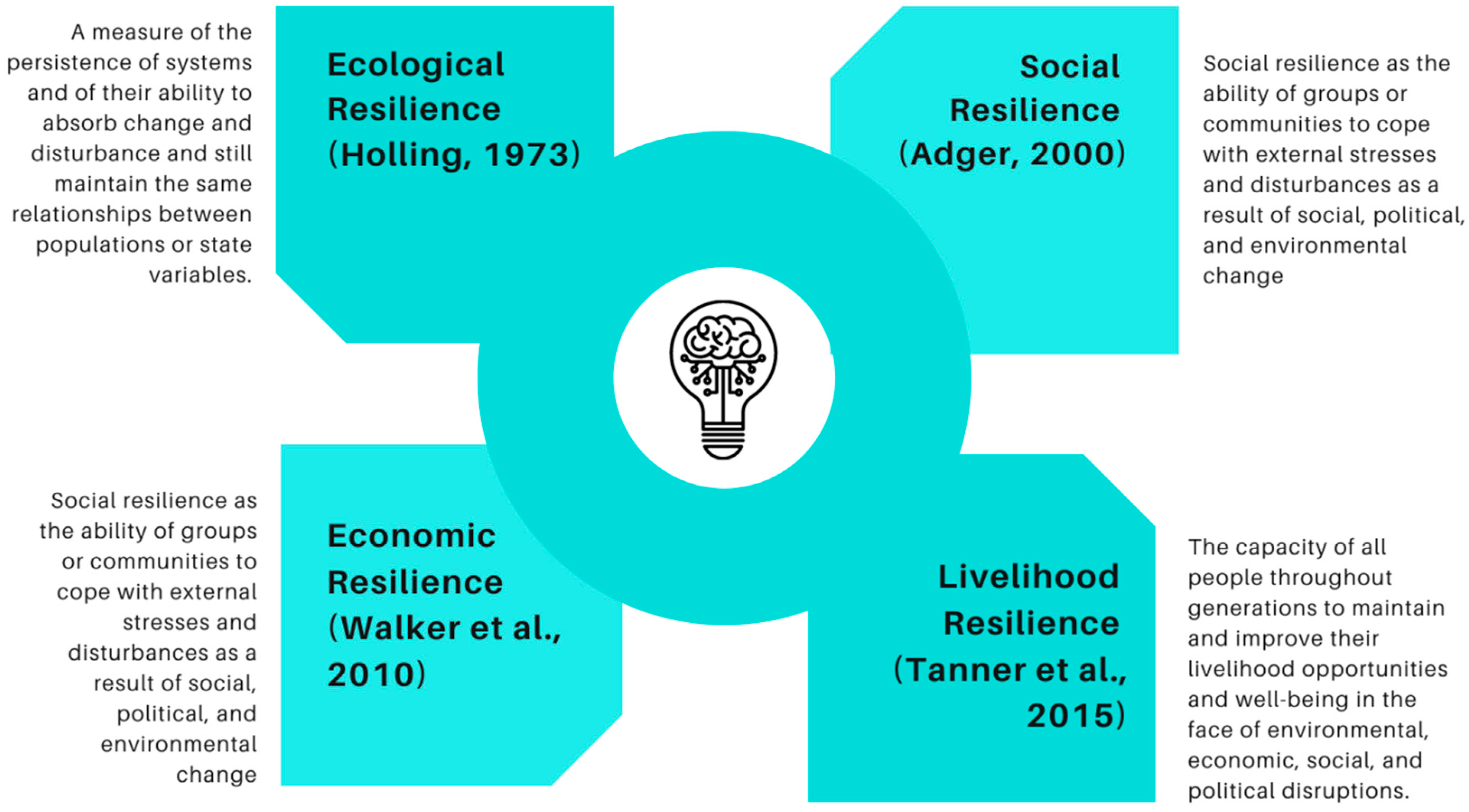
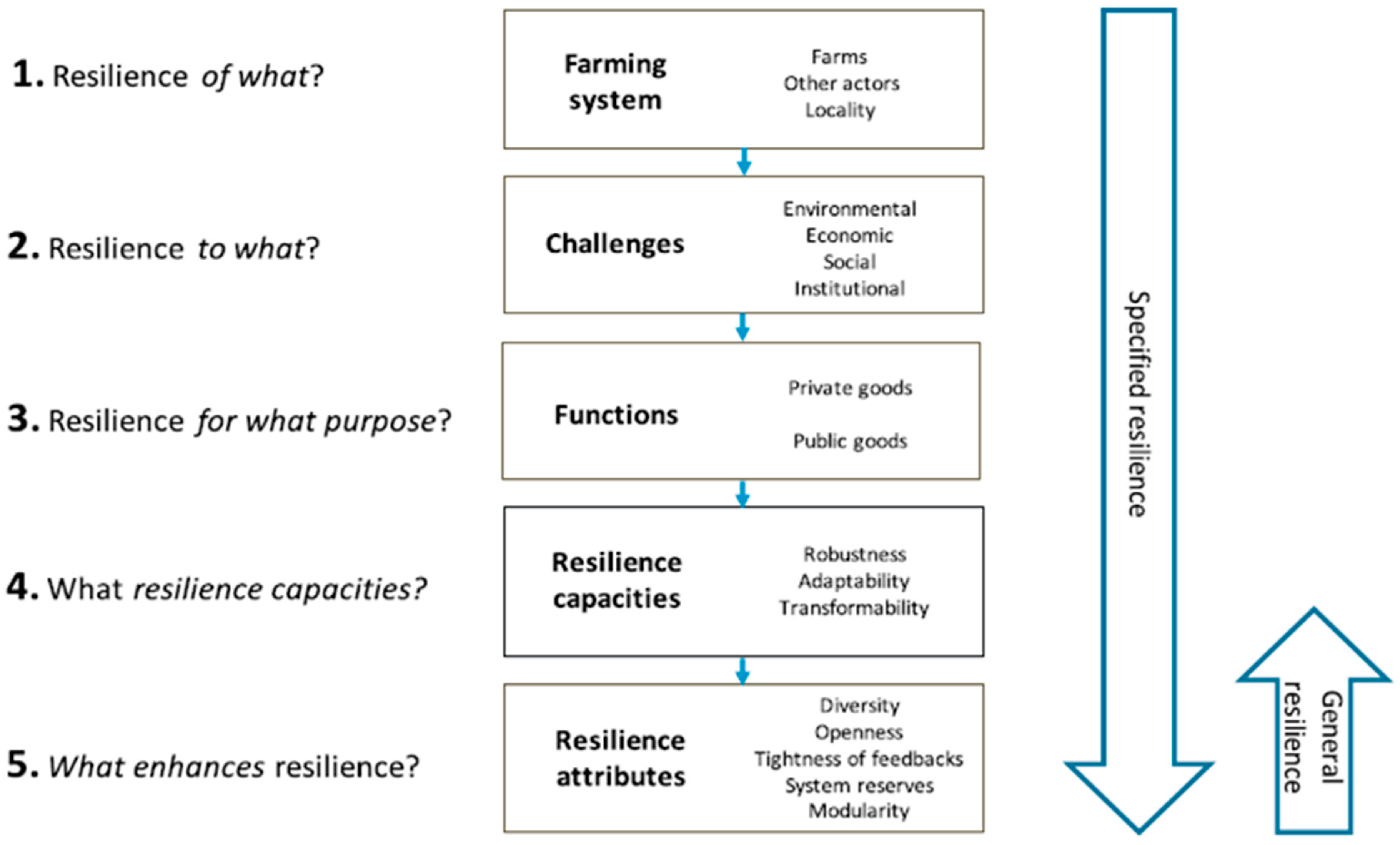


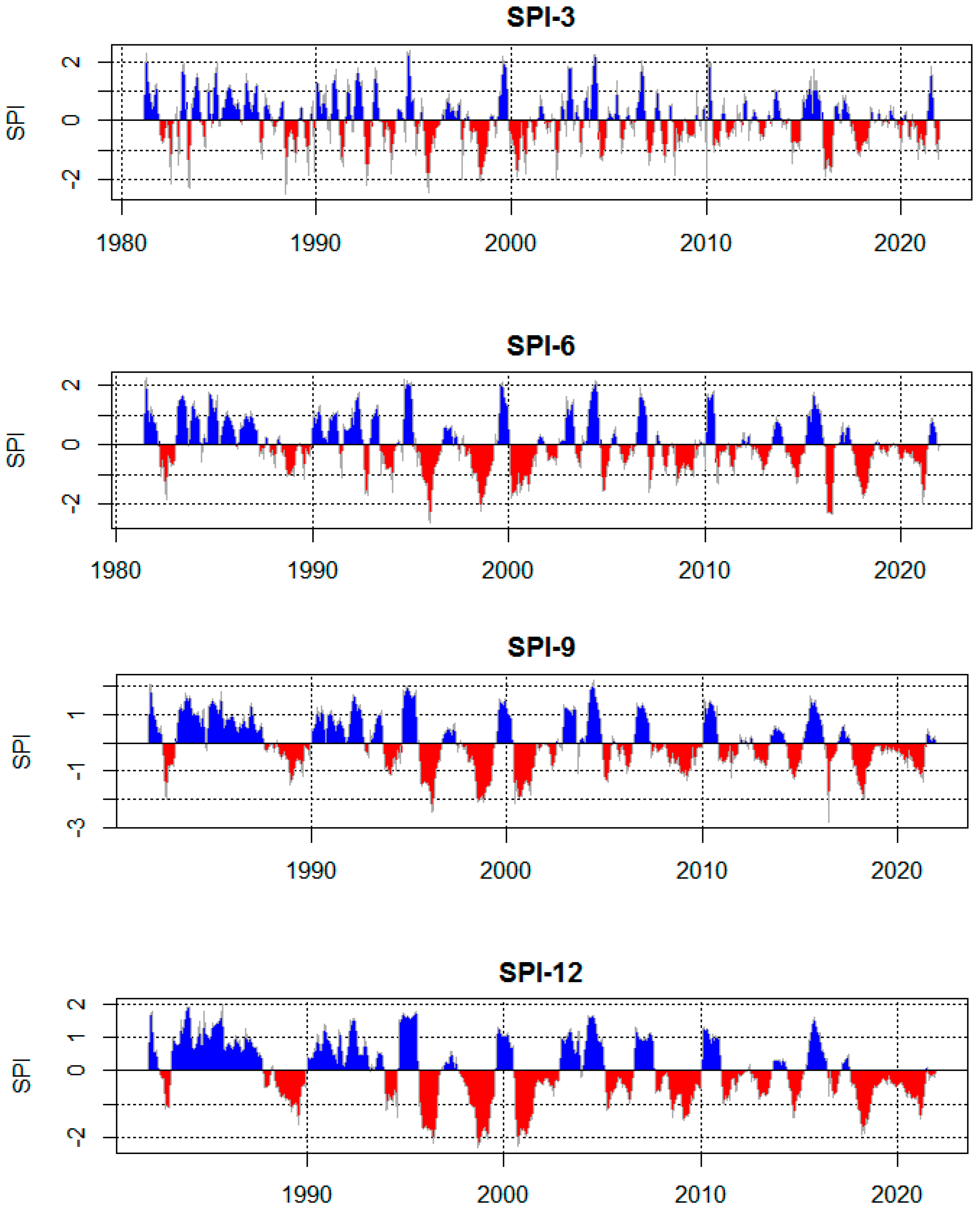






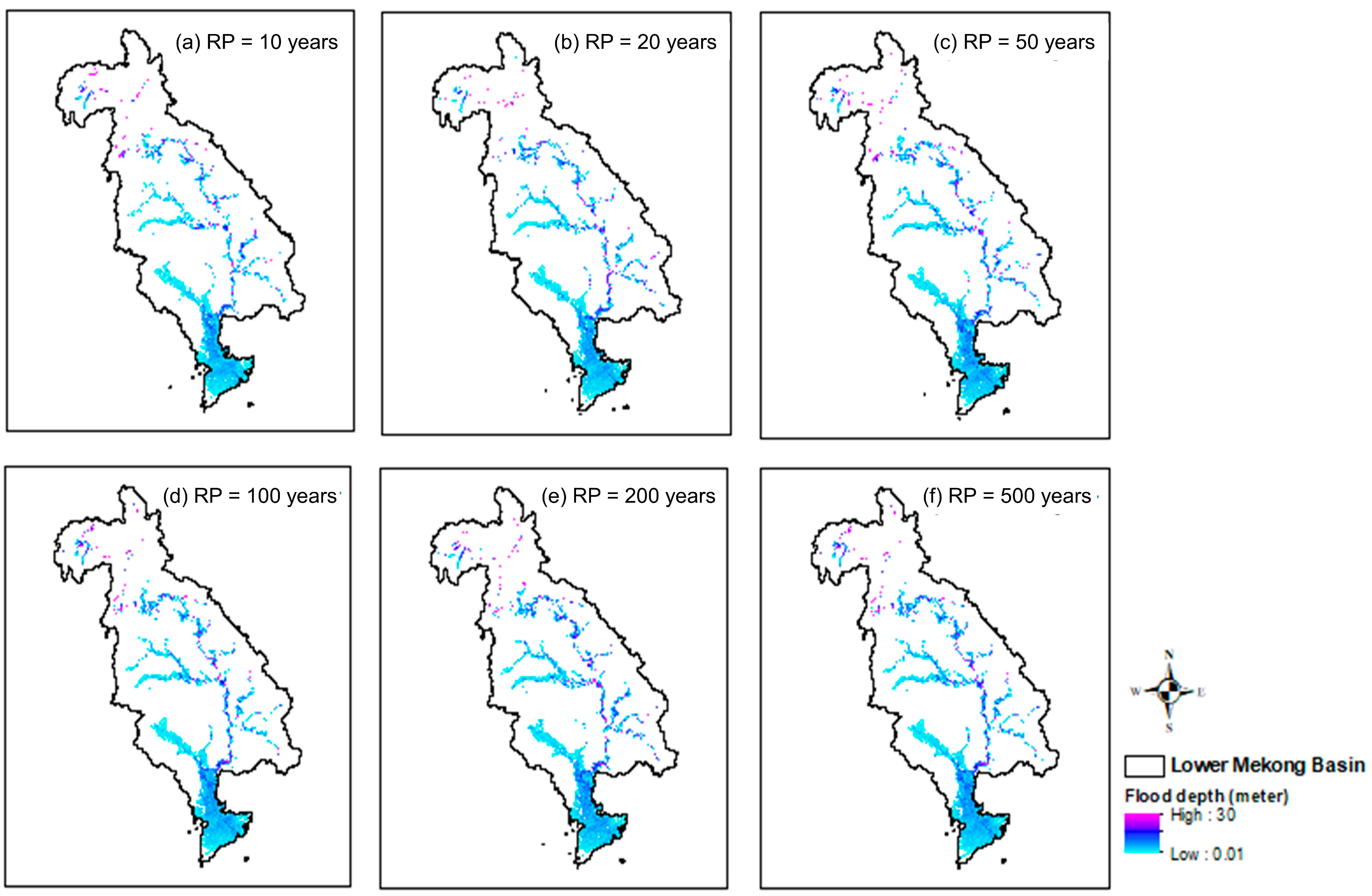
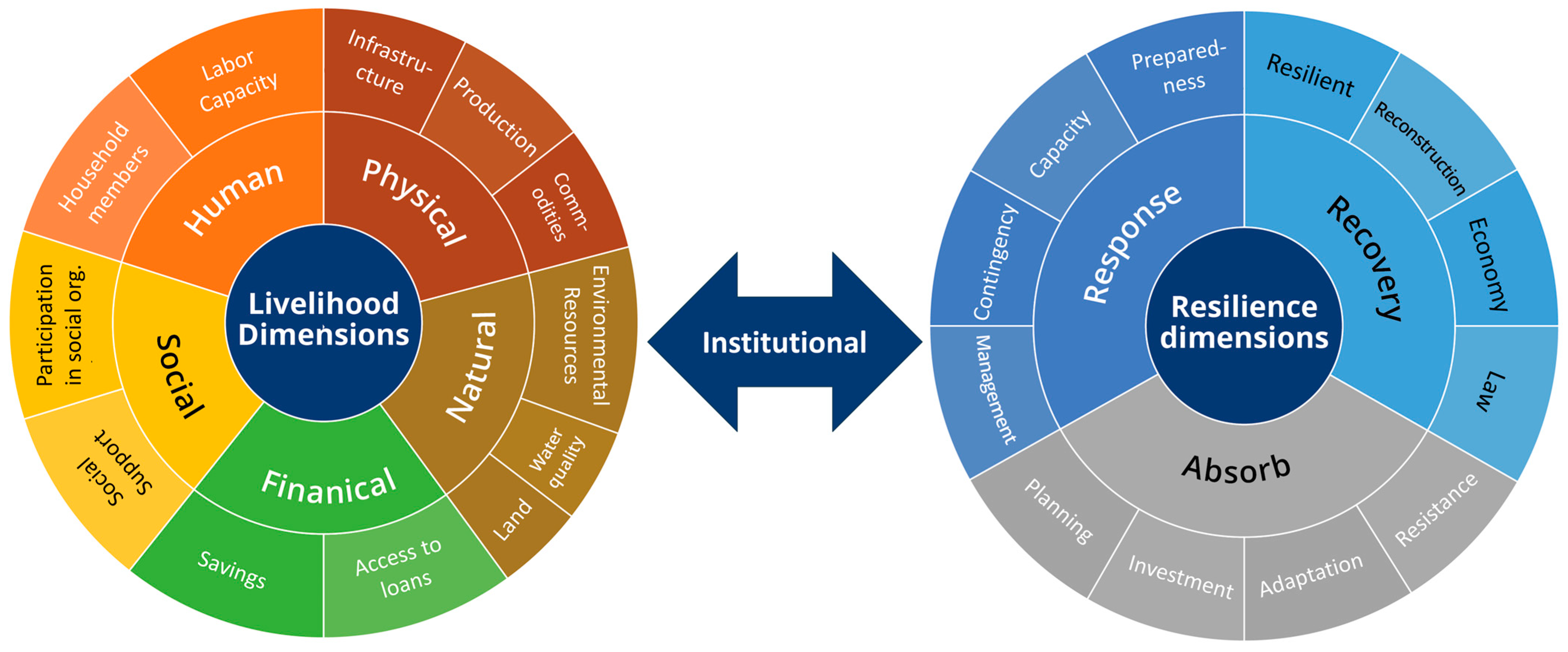
| SPI Value | Interpretation |
|---|---|
| ≥2.0 | Extremely wet |
| 1.5 to 1.99 | Severely wet |
| 1.0 to 1.49 | Moderately wet |
| 0.99 to −0.99 | Near normal |
| −1.0 to −1.49 | Moderately dry |
| −1.5 to −1.99 | Severely dry |
| ≤−2.0 | Extremely dry |
| Range of TDD | Range of ADD | Range of MDD | |
|---|---|---|---|
| SPI-3 | 0 to 28 | 1 to 2.167 | 0 to 3 |
| SPI-6 | 0 to 90 | 1 to 5 | 0 to 19 |
| SPI-9 | 0 to 100 | 1 to 7.167 | 0 to 35 |
| SPI-12 | 0 to 112 | 1 to 12.22 | 0 to 47 |
| Range of TDS | Range of ADS | Range of MDS | |
|---|---|---|---|
| SPI-3 | 0 to −33.259 | −1.03 to −2.479 | 0 to −3.800 |
| SPI-6 | 0 to −132.965 | −1.032 to −6.708 | 0 to −26.530 |
| SPI-9 | 0 to −150.639 | −1.031 to −10.111 | 0 to −49.278 |
| SPI-12 | 0 to −169.722 | −1.035 to −17.302 | 0 to −72.429 |
| Range of TDI | Range of ADI | Range of MDI | |
|---|---|---|---|
| SPI-3 | 0 to −1.403 | 0 to −0.055 | 0 to −1.656 |
| SPI-6 | 0 to −1.545 | 0 to −0.091 | 0 to −2.262 |
| SPI-9 | 0 to −1.806 | 0 to −0.080 | 0 to −3.067 |
| SPI-12 | −1.034 to −2.067 | 0 to −0.067 | 0 to −4.376 |
| Cambodia | Thailand | Vietnam | |
|---|---|---|---|
| Resilience OF WHAT | Livelihood System: 1. Farming (Paddy) 2. Horticulture (Vegetables) 3. Textile Industry | Livelihood System: 1. Farming (Paddy) 2. Livestock 3. Aquaculture | Livelihood System: 1. Farming (Paddy) 2. Small businesses owned by families 3. Aquaculture |
| Resilience TO WHAT | Hazards: 1. Floods 2. Droughts 3. Wind Storms | Hazards: 1. Droughts 2. Floods 3. Tropical Storms | Hazards: 1. River bank erosion/landslide 2. Floods |
| Resilience for WHAT Purposes | 1. Ability of farmers to maintain the farm production | 1. Household food and bioresources security 2. Improving the economic status (income) of the communities | 1. Land protection (protecting land from erosion) 2. Avoid physical damage to buildings 3. Ensure operations of small businesses 4. Psychological well being |
| WHAT are Resilience Capacities? | 1. Flood Control Structures 2. Flood Early Warning Systems 3. Agro-advisory 4. Irrigation Infrastructures 5. Drought/flood tolerant crop varieties 6. Farm Produce Storage Structures | 1. Drought/flood tolerant plants species, crop diversification 2. Agro-advisory 3. Precision farming (technological interventions) 4. Climate-resilient irrigation and water supply system 5. Early warning system and information sharing | 1. Land Use Planning 2. Structural Mitigation Measures (embankments, dykes) 3. Early Warning Systems |
| WHAT (strategies) enhance resilience? | 1. Robust/strong market supply chain 2. Investment in agriculture (financial support) 3. Capacity building of improved farming practices 4. Improving institutional functions and capacities | 1. Stakeholder engagement in planning/decision making Government organizations Academia/research Farmers, NGOs and CBOs and Private sectors 2. Collaboration for technology transfer 3. Policies | 1. Strategies for temporary displacement and resettlement 2. Increase community awareness 3. Technical and financial support for house and building construction |
| Unit of Analysis (Admin Levels) | Province: Kandal Districts: (1) Mukh Kampul (2) Sang | Province: Sakon Nakhon District: (1) Mueang District (2) Phon Na Kaeo District) | Province: An Giang District: (1) Cho Moi (2) Chau Phu |
Disclaimer/Publisher’s Note: The statements, opinions and data contained in all publications are solely those of the individual author(s) and contributor(s) and not of MDPI and/or the editor(s). MDPI and/or the editor(s) disclaim responsibility for any injury to people or property resulting from any ideas, methods, instructions or products referred to in the content. |
© 2023 by the authors. Licensee MDPI, Basel, Switzerland. This article is an open access article distributed under the terms and conditions of the Creative Commons Attribution (CC BY) license (https://creativecommons.org/licenses/by/4.0/).
Share and Cite
Pal, I.; Dhungana, G.; Baskota, A.; Udmale, P.; Gadhawe, M.A.; Doydee, P.; Nguyen, T.T.N.; Sophat, S. Multi-Hazard Livelihood Security and Resilience of Lower Mekong Basin Communities. Sustainability 2023, 15, 8469. https://doi.org/10.3390/su15118469
Pal I, Dhungana G, Baskota A, Udmale P, Gadhawe MA, Doydee P, Nguyen TTN, Sophat S. Multi-Hazard Livelihood Security and Resilience of Lower Mekong Basin Communities. Sustainability. 2023; 15(11):8469. https://doi.org/10.3390/su15118469
Chicago/Turabian StylePal, Indrajit, Ganesh Dhungana, Ayush Baskota, Parmeshwar Udmale, Mayuri Ashokrao Gadhawe, Puvadol Doydee, Tanh T. N. Nguyen, and Seak Sophat. 2023. "Multi-Hazard Livelihood Security and Resilience of Lower Mekong Basin Communities" Sustainability 15, no. 11: 8469. https://doi.org/10.3390/su15118469
APA StylePal, I., Dhungana, G., Baskota, A., Udmale, P., Gadhawe, M. A., Doydee, P., Nguyen, T. T. N., & Sophat, S. (2023). Multi-Hazard Livelihood Security and Resilience of Lower Mekong Basin Communities. Sustainability, 15(11), 8469. https://doi.org/10.3390/su15118469








